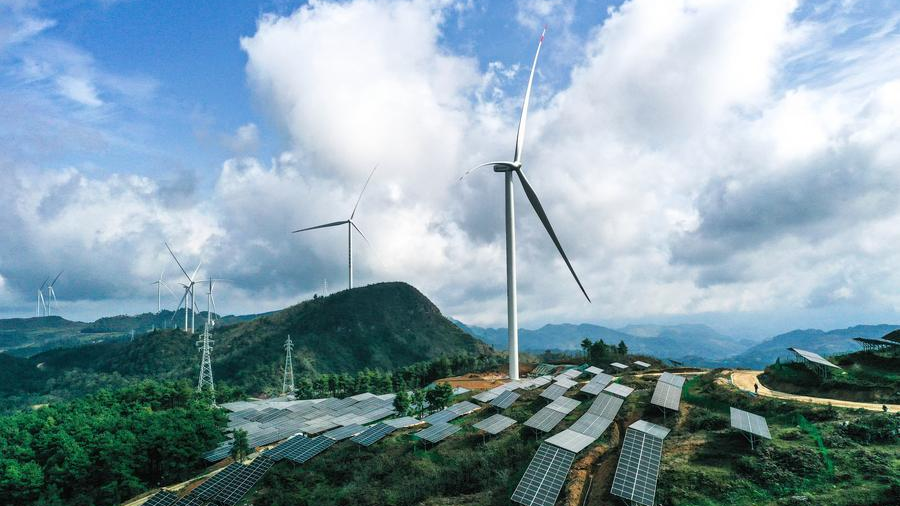
The Dingdongpo wind power-photovoltaic project in Tongren City, southwest China's Guizhou Province, November 16, 2023. [Photo/Xinhua]
By Nikola Mikovic
Over the past decade, most major energy forums have been taking place in various Asian countries – from Thailand, through Malaysia and Japan, to China. From July 31, Beijing will host the three-day China Energy Summit and Exhibition 2024 where experts from all over the globe will discuss energy security, climate change, and the low-carbon economy.
The core topics will also include the roles of hydrogen and ammonia in meeting energy demand and energy security, as well as prospects for the liquefied natural gas (LNG) market. During the recent third plenary session of the 20th Central Committee of the Communist Party of China, energy-related topics also had a special place. According to the resolution on further deepening reform comprehensively to advance Chinese modernization, China will "prioritize ecological protection, conserve resources and use them efficiently, and pursue green and low-carbon development."
"We must work to improve ecological conservation systems and make concerted efforts to cut carbon emissions, reduce pollution, pursue green development, and boost economic growth," the document states.
China remains committed to expanding energy cooperation with countries around the world and is focusing its energy development on clean energy, such as green hydrogen. The world's second largest economy is gradually becoming a technological leader in the green energy sector, which will not only drive energy transformation in Asia, but also set a global example for low-carbon development.
China has already started increasing production of green hydrogen as an important clean energy source. Although the hydrogen industry is still in its infancy worldwide, China seems to have become a leader in producing the essential technology for green hydrogen. That is why Germany wants to expand cooperation with Beijing in the field of hydrogen technology, while Malaysia seeks China's help to develop its country's green hydrogen energy industry.
Malaysian company Semarak Renewable Energy and China Hydropower (Malaysia) Company, a subsidiary of Power Construction Corporation of China (PowerChina), have recently signed an agreement to develop Malaysia's first large-scale green hydrogen production project using floating photovoltaic power generation. More importantly, China's Zhejiang Geely Holding Group, the world's largest producer of methanol vehicles, intends to focus on Malaysia as the next market for its new lines of cars powered by methanol, whose fuel emission damages are lower than those of diesel fuel.
Indeed, the world's energy transition from fossil fuels to renewables, in many ways, is heavily dependent on Asia. China's rapid adoption of clean energy positions the country as a de facto green energy leader, not only in Asia but globally. That is why at the China Energy Summit and Exhibition 2024 Chinese energy officials and experts are expected to lead the conversation shaping the future of energy in Asia and beyond.
Asia is particularly important given that it is moving into a leadership role in the world economy. The swift expansion of Asian economies has propelled Asian countries to the forefront in the production of electric vehicles and microchips. Asian nations are also becoming a leading force in technological innovation. As a result, Asia already consumes the most primary energy in the world, which is why energy flows – not only from Russia, but also from Central Asia and the Middle East – will almost certainly continue to move eastward.
According to Parag Khanna, a prominent global strategy advisor, the future belongs to Asia. That is the title of his book published in 2019. That year, a study by BP showed that Asia, including China and India, will represent 43 percent of global energy demand by 2040.
It is India that currently seems to benefit from the European Union's "energy divorce" from Russia. Over the past two years, Russia has significantly increased its crude oil exports to India. The EU's imports of refined oil imports from India grew to record levels in 2023, which indicates that New Delhi is now importing cut-price Russian oil, and then selling it to EU nations at full price once the oil has been refined.
China, on the other hand, is set to overtake the European Union as the main consumer of Russian natural gas. Moreover, as the world's largest importer of LNG, China continues building LNG terminals all over the country. That, however, does not mean that the Chinese strategic planners will concentrate all of their efforts on gas imports.
It is no secret that Beijing's long-term goal is to become energy self-sufficient. According to the Goldman Sachs forecast, that could happen by 2060. Meanwhile, China will undoubtedly seek to further develop its green energy production, as it seems to be poised to lead the global energy transition.
Finally, with significant events like the China Energy Summit and Exhibition 2024, Asian nations' commitment to sustainable development and technological innovation underscores the region's pivotal role in shaping the future of global energy.
Nikola Mikovic, a special commentator on current affairs for CGTN, is a freelance journalist in Serbia. He covers mostly Russian, Ukrainian and Belarusian foreign policy issues and writes for multiple web magazines.

 中文
中文



